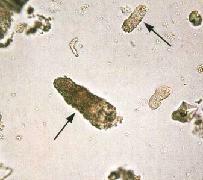 The appearance of cylinders in the urine is called cylilluria. They represent a kind of sediment in the fluid when urinating, having a cylindrical shape.
The appearance of cylinders in the urine is called cylilluria. They represent a kind of sediment in the fluid when urinating, having a cylindrical shape.
Different types of cylinders make it possible to recognize diseases of the lower zone of the genito-urinary tract (urethritis, etc.), as well as developing violations of the functional capacity of the kidneys.
Discovered cylinders when passing urine analysis, which include erythrocytes, testify to acute diffuse glomerulonephritis. If bacterial cylinders were detected in urine, this indicates the presence of bacterial pyelonephritis. In addition, the cylinders carry only those harmful microorganisms, which triggered the appearance of the disease.
Cylinders in urine - what does this mean?
Depending on what pathological processes occur in the urinary system of man, there are also different pathological cylinders in the urine. Therefore, the laboratory assistant and specifies which cylinders in the general analysis of urine are found, namely:
- Hyaline Cylinders- can stand out against the background of complete human health, with the microscopy of urinary sediment in the norm should be no more than 1-2 cylinders per field of view.
- Granular cylinders- represent a protein impression of tubules with an admixture of cells of the renal epithelium.
- Wax-shaped cylinders- represent the formation of a homogeneous semitransparent mass.
- Erythrocyte Cylinderstestify to the renal origin of hematuria (with acute glomerulonephritis, chronic glomerulonephritis, kidney cancer, fornicinal bleeding, etc.).
- Epithelial Cylindersin the absence of pathology of the kidneys in the urine are not detected. The appearance of epithelial cylinders indicates severe degenerative changes in the tubular apparatus of the kidneys. They occur with nephrosis and severe lesions (sulemoma, etc.).
- Pseudocylindersare formed from mucus, resemble hyaline cylinders. Can form from the sediment of uric acid salts: they are red, resembling pigmented blood cylinders.
What does it mean? The appearance of cylinders of any type in the urine - an alarm signal, indicating that the functional units of the kidneys - nephrons - are under attack.
Cylinders hyaline in urine
Formed from denatured protein in the renal tubules under the influence of acid urine reaction. Extremely gentle, pale, transparent formations, under bright illumination, are barely noticeable, for better diagnosis, the sediment can be tinted with methylene blue, gentianiviolet, eosin, iodine tincture. On their surface can be a light granularity due to the deposition of amorphous salts or cellular detritus, which can make it difficult to differentiate from granular cylinders.
Normally, the number of hyaline cylinders does not exceed 1-2 in the preparation, they appear with physical activity, increase in body temperature, constant availability protein in the urine, nephrotic syndrome, measles, rubella, chicken pox, influenza, parainfluenza, adenovirus infection, poliomyelitis, parotitis, HIV / AIDS of other infectious diseases (pertussis, scarlet fever, diphtheria, meningococcal infection, tuberculosis) accompanied by an increase in body temperature.
Granular cylinders in the urine
This is a mold of the kidney of the kidney, consisting of a protein curdled in acid urine, to the surface of which the dystrophically altered epithelial cells of the tubules attach. As a result of this, Ts. acquire a granular appearance, and their color is darker in comparison with hyaline.
Granular cylinders in the urine appear against a background of diseases accompanied by damage to the kidney tubules and proteinuria (protein in the urine): chronic glomerulonephritis, renal amyloidosis, diabetic nephropathy, pyelonephritis, viral diseases accompanied by fever.
Wax-like cylinders in urine
Wax-shaped cylinders consist of a homogeneous, structureless material, similar to wax, yellowish in color; are formed in the distal sections of the tubules due to dystrophy and atrophy (necrobiosis) of the tubular epithelium of these parts, which is usually observed in severe acute kidney damage (for example, in subacute malignant glomerulonephritis) or in the late stage of renal disease and chronic renal failure. Therefore, their detection in the urine is regarded as a prognostically unfavorable symptom.
Leukocyte Cylinders
Particularly characteristic for pyelonephritis, to a lesser extent for lupus nephritis and some other diseases.
Epithelial Cylinders
They are of kidney origin and appear with necrosis of renal tubules, poisoning with heavy metals. The appearance of these cylinders is the indicator of allograft rejection (a few days after the operation).
Erythrocyte Cylinders
Present in the urine with acute progressive glomerulonephritis and some other kidney diseases (kidney infarction, renal vein thrombosis), as well as with polyarthritis, severe hypertension.
Cylinders
Formations of cylindrical form, consisting of mucus. Single cylindroids can sometimes occur in the urine of a healthy person. A significant number of them can be found during inflammatory processes in the urinary tract.

How to choose probiotics for the intestine: a list of drugs.

Effective and inexpensive cough syrups for children and adults.

Modern non-steroidal anti-inflammatory drugs.

Review of tablets from the increased pressure of the new generation.
 Antiviral drugs are inexpensive and effective.
Antiviral drugs are inexpensive and effective.



